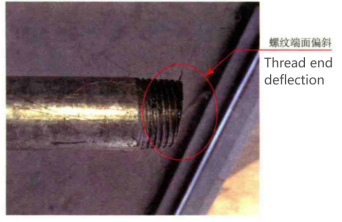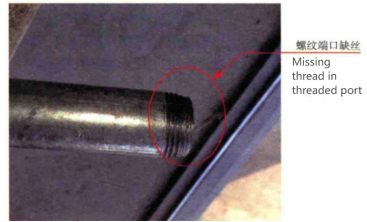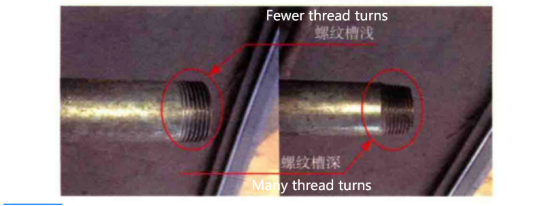Nov. 27, 2023
Threaded connections, flange connections, welded connections, hot melt connections, compression connections, etc. are commonly used connection methods in urban gas engineering pipelines. The specific pipeline connection method to be adopted is related to the transmission medium, pressure, temperature, pipe material, pipe diameter and other factors. It is clearly stated in the engineering design document and cannot be changed at will.
Pipe connection is a key link in the entire pipeline installation project and is essential to ensure the normal operation of the pipeline system. Any quality defects that occur during the connection process may lead to quality accidents. This public account will compile some regulations and common quality problems regarding pipeline connections during project construction for your reference.
(1) Phenomenon and legend
If the angle between the pipe thread port and the pipe axis is less than or greater than 90°, obvious deflection can be seen (see the figure below).

(2) Harm
The thread length deviation is large, and the sealing surface on the shorter side after connection is small and prone to leakage.
(3) Cause analysis
1) The cutting machinery and equipment are aging, there is mechanical wear, and the grinding wheel of the cutting machine is not perpendicular to the chassis;
2) The pipe is placed unevenly during cutting;
3) The pipe bends itself.
(4) Prevention and control measures
1) The cutting mechanical performance is good. Before cutting, focus on checking the flexibility of the power button, the effectiveness of the protective cover, the verticality of the grinding wheel and the chassis, etc., and mark it after passing the test;
2) When cutting, the pipe should be close to the cutting machine chassis, leveled, and effectively fixed to the clamping device; when the pipe is long, an adjustable bracket should be placed on the other side to ensure that the pipe is parallel to the chassis surface;
3) When cutting, keep the cutting machine grinding wheel and the pipe perpendicular, and use a square ruler for sampling inspection; the cutting process should be slow, the force should be uniform, and the force should not be too large;
4) The pipe should be straight. Visually inspect the appearance before cutting. If the deviation is small, it can be straightened. If the deviation is large, it should not be used.
(1) Phenomenon and legend
The processed threaded threads have partial or continuous broken wires or missing wires (see the picture below).

(2) Harm
Broken threads or missing threads can easily cause leakage at the connection.
(3) Cause analysis
1) When threading, it is not carried out from shallow to deep, and is carried out in several passes, and the amount of cutting at one time is too large;
2) The thread die used is blunt or damaged;
3) The threading machine is short of oil or the oil circuit is blocked; 4) The quality of the pipe is unqualified and the hardness is high.
(4) Prevention and control measures
1) Pipe threading generally determines the number of threading processes according to the size of the pipe. Pipe diameters less than or equal to DN20 can be set in one time; pipe diameters between DN25 ~ DN40 should be set in two times; pipe diameters of DN50 and above should be set in three times. When threading for the second time, when the movable dial of the first or second hinge plate is aligned with the fixed dial scale, it should be slightly larger than the corresponding scale;
2) Check the dies on the head of the threading machine to see if there is any bluntness or damage. If any defects are found, replace them promptly. For seriously worn dies, all (4) dies should be replaced, and not only one defective one should be replaced;
3) The oil tank of the threading machine should be filled with lubricating oil before threading. If the oil discharge is not smooth, clear the oil suction and oil outlet pipelines of the threading machine in time, and collect the iron filings in the oil pan. Wait until the oil output of the threading machine is normal. Then perform threading;
4) The pipes used for threading should have quality certification documents from the manufacturer, and their main chemical composition should comply with the relevant manufacturing standards. There should be no cracks, folds, scarring, rolling or delamination defects after visual inspection.
(1) Phenomenon and legend
The thread profile has a wide flat top, a shallow thread groove, and a low number of thread teeth; the outer diameter of the thread is significantly smaller than the outer diameter of the pipe, the thread groove is deep, and the number of thread teeth is too high (see the picture below).

(2) Harm
1) If the thread groove is shallow, the pipe fitting is difficult to screw on, or the screwing length is not enough, which may cause leakage, or the pipe hoop may crack due to forced screwing;
2) If the thread groove is deep, the pipe will be screwed directly into the bottom of the pipe fitting, which will hinder the flow of the medium and easily cause leakage and head loss; at the same time, the pipe wall at the threaded connection will be thinned and the pipe connection will be easily broken.
(3) Cause analysis
1) The thread groove is shallow due to insufficient threading times; the threading machine joint scale mark is loose and the threading die is worn; the outer diameter of the pipe is small;
2) The depth of the thread groove is due to the threading feed being too deep; 3) The scale adjustment of the threading machine head is incorrect.
(4) Prevention and control measures
1) Before threading, check the scale mark plate of the threading machine head. The scale should be clear and the sliding should be flexible; the threading die should have no missing teeth, broken teeth or serious wear; the outer diameter of the pipe should meet the standard requirements;
2) Determine the number of threading passes and the feed amount of the die according to the size of the pipe diameter, first appropriately relax the machine head scale value, and then gradually adjust it to the standard value;
3) Before the formal threading of each specification of pipe, a sample must be processed first, and the pipe fittings should be used for trial twisting. After passing the inspection, the scale of the machine head mark plate should be locked, and subsequent threading should be based on this scale.
SAFER
PRODUCT INFO
ABOUT JIANZHI
TECH DATA
Contact Us
E-mail: sales1@jianzhi-fitting.com
Tel: +86 18698027872
Office In Tianjin:
Heping District, Tianjin, China.
Production Base 1:
Chifeng, Inner Mongolia, China.
Production Base 2:
Tangshan City, Hebei Province, China.
Production Base 3:
Schelei Street,Baicoi City,Prahova County,Romania
Service email: info.ro@jianzhi-fitting.com
Sales email: market.ro@jianzhi-fitting.com
Tel: +40(755)011 849
